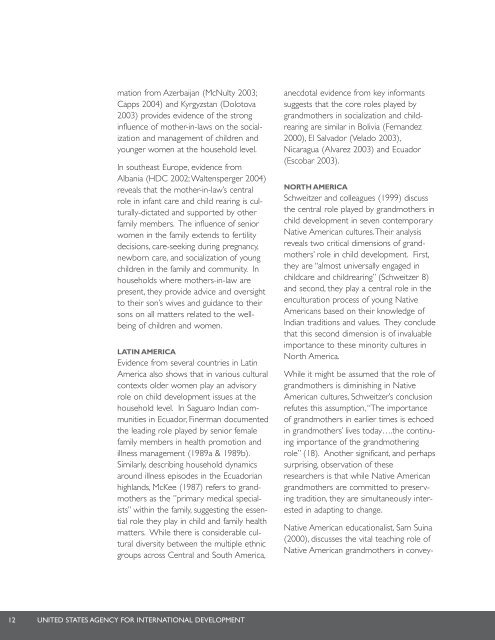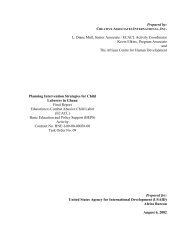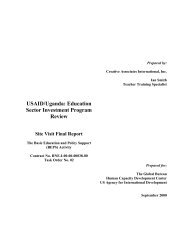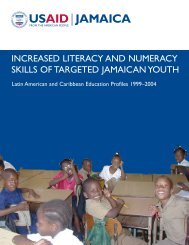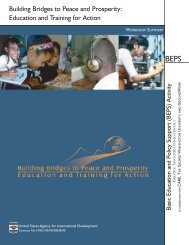mation from Azerbaijan (McNulty 2003;Capps 2004) <strong>and</strong> Kyrgyzstan (Dolotova2003) provides evidence of the stronginfluence of mother-in-laws on the socialization<strong>and</strong> management of children <strong>and</strong>younger women at the household level.In southeast Europe, evidence fromAlbania (HDC 2002; Waltensperger 2004)reveals that the mother-in-law’s centralrole in infant care <strong>and</strong> child rearing is culturally-dictated<strong>and</strong> supported by otherfamily members. The influence of seniorwomen in the family extends to fertilitydecisions, care-seeking during pregnancy,newborn care, <strong>and</strong> socialization of youngchildren in the family <strong>and</strong> community. Inhouseholds where mothers-in-law arepresent, they provide advice <strong>and</strong> oversightto their son’s wives <strong>and</strong> guidance to theirsons on all matters related to the wellbeingof children <strong>and</strong> women.LATIN AMERICAEvidence from several countries in LatinAmerica also shows that in various culturalcontexts older women play an advisoryrole on child development issues at thehousehold level. In Saguaro Indian communitiesin Ecuador, Finerman documentedthe leading role played by senior femalefamily members in health promotion <strong>and</strong>illness management (1989a & 1989b).Similarly, describing household dynamicsaround illness episodes in the Ecuadorianhighl<strong>and</strong>s, McKee (1987) refers to gr<strong>and</strong>mothersas the ”primary medical specialists”within the family, suggesting the essentialrole they play in child <strong>and</strong> family healthmatters. While there is considerable culturaldiversity between the multiple ethnicgroups across Central <strong>and</strong> South America,anecdotal evidence from key informantssuggests that the core roles played bygr<strong>and</strong>mothers in socialization <strong>and</strong> childrearingare similar in Bolivia (Fern<strong>and</strong>ez2000), El Salvador (Velado 2003),Nicaragua (Alvarez 2003) <strong>and</strong> Ecuador(Escobar 2003).NORTH AMERICASchweitzer <strong>and</strong> colleagues (1999) discussthe central role played by gr<strong>and</strong>mothers inchild development in seven contemporaryNative American cultures.Their analysisreveals two critical dimensions of gr<strong>and</strong>mothers’role in child development. First,they are “almost universally engaged inchildcare <strong>and</strong> childrearing” (Schweitzer 8)<strong>and</strong> second, they play a central role in theenculturation process of young NativeAmericans based on their knowledge ofIndian traditions <strong>and</strong> values. They concludethat this second dimension is of invaluableimportance to these minority cultures inNorth America.While it might be assumed that the role ofgr<strong>and</strong>mothers is diminishing in NativeAmerican cultures, Schweitzer’s conclusionrefutes this assumption, “The importanceof gr<strong>and</strong>mothers in earlier times is echoedin gr<strong>and</strong>mothers’ lives today….the continuingimportance of the gr<strong>and</strong>motheringrole” (18). Another significant, <strong>and</strong> perhapssurprising, observation of theseresearchers is that while Native Americangr<strong>and</strong>mothers are committed to preservingtradition, they are simultaneously interestedin adapting to change.Native American educationalist, Sam Suina(2000), discusses the vital teaching role ofNative American gr<strong>and</strong>mothers in convey12 UNITED STATES AGENCY FOR INTERNATIONAL DEVELOPMENT
ing to children their connectedness withtheir elders, their ancestors, <strong>and</strong> the earth.He discusses the problems of disconnectedness(with traditional values <strong>and</strong> ceremonies)<strong>and</strong> dysfunction in contemporaryNative American families <strong>and</strong> schools <strong>and</strong>the role of wise gr<strong>and</strong>mothers in promotinginterrelatedness <strong>and</strong> continuity inNative beliefs, values, <strong>and</strong> practices. It islargely through storytelling that gr<strong>and</strong>mothershelp children connect with Nativepeople’s language, values, <strong>and</strong> cultural traditions.In various Native American culturesthe vital teaching role of gr<strong>and</strong>mothers isdepicted in a visual image, reproducedeither on paper or in clay, of a large gr<strong>and</strong>motherwith numerous small children ontop of <strong>and</strong> around her. This image profoundlyreflects the dual teaching <strong>and</strong> nurturingrole of gr<strong>and</strong>mothers in NativeAmerican cultures.Similarly, in Sioux culture gr<strong>and</strong>parents playa vital role “as cultural links to the traditionsof the past <strong>and</strong> as isl<strong>and</strong>s of certaintyin ever-changing society.” Native Americaneducationalist Kincheloe (Kincheloe &Kincheloe 1983) describes the importantrole of gr<strong>and</strong>mothers in child developmentfrom the time of birth, as child-care supportfor busy mothers <strong>and</strong> as educatorson all aspects of life. The authors lamentthe fact that formal schools do not incorporatethe knowledge <strong>and</strong> wisdom of theelder, traditional Sioux educators. “Theschools must not contribute to Americansociety’s tendency to push olderAmericans into the background” (136).She asserts that most formal teachersignore the fact that gr<strong>and</strong>parents constitutea valuable resource <strong>and</strong> ensure the“cultural link” in the development of Siouxchildren. She poignantly argues, “Societyitself fails when it isolates the young <strong>and</strong>the old from one another” (135).AUSTRALIA AND THE PACIFICIn all Aboriginal societies in Australia,respect for the family, tradition, <strong>and</strong> theelders are important precepts. Within thisframework, senior Aboriginal women areexpected to serve as advisors <strong>and</strong> guidesfor young women <strong>and</strong> families (Wilson1999; Koori Elders et al. 1999). As regardsthe health <strong>and</strong> well-being of women <strong>and</strong>children, senior women are expected toshare their expertise <strong>and</strong> pass on to themtraditional ways of promoting health <strong>and</strong>healing.In The Pacific there has been virtually nopublished research on the role of gr<strong>and</strong>mothersin children’s development, accordingto well-known public health doctors,Biuwaimai (1997) <strong>and</strong> Kataouanga (1998),public health nutritionist, Susan Parkinson(2003), <strong>and</strong> community development practitioner,Wanga (2002). On the otherh<strong>and</strong>, all four of these key informants stateunequivocally that in all Pacific isl<strong>and</strong> cultures,older women have played in thepast, <strong>and</strong> continue to play, a significant roleat the household level in all matters relatedto child health <strong>and</strong> development.Parkinson states that in both rural, <strong>and</strong> socalled“urban contexts,” senior women playan important role in childcare, <strong>and</strong> particularlywith infants (2003). She states that inboth major ethnic groups in Fiji, theIndigenous Fijians, <strong>and</strong> Indo-Fijians, bothgrannies <strong>and</strong> aunties in the family areimportant household advisors <strong>and</strong> teachGRANDMOTHERS:THE LEARNING INSTITUTION13
- Page 1 and 2: GRANDMOTHERS:A LEARNING INSTITUTION
- Page 3: GRANDMOTHERS:A LEARNING INSTITUTION
- Page 11 and 12: EXECUTIVE SUMMARYSociety itself fai
- Page 13 and 14: Education, the Bernard Van LeerFoun
- Page 15 and 16: SEVERAL FACTORS CONTRIBUTE TO THELI
- Page 17: - Who am I? Assign children to askf
- Page 20 and 21: in educational activities on home t
- Page 22 and 23: “A grandmother’s understandingo
- Page 24 and 25: “Culture tells peoplehow to view
- Page 26 and 27: attention given to grandmothers’
- Page 28 and 29: social work, including family syste
- Page 32 and 33: “The status of eldersin tradition
- Page 34 and 35: “As women, thegrandmothers haveli
- Page 36 and 37: members often consult the moreexper
- Page 38 and 39: “Social capital is a community’
- Page 40 and 41: In a collaborative effort between
- Page 42 and 43: in-laws and the additional free tim
- Page 44 and 45: "Involving grandmothersin community
- Page 50 and 51: CULTURALLY-ADAPTED EDUCATIONMATERIA
- Page 52 and 53: strated the power of participatory
- Page 54 and 55: effects of the new ideas, their con
- Page 57 and 58: V. GRANDMOTHERS: A LEARNING INSTITU
- Page 59 and 60: Many health and development workers
- Page 61 and 62: VI. RECOMMENDATIONS FORBASIC EDUCAT
- Page 63 and 64: parents themselves did not go to sc
- Page 65 and 66: community ties by increasing teache
- Page 67 and 68: of millions. On the other hand, som
- Page 69: teachers, teacher abuse of children
- Page 73 and 74: APPENDIX B:ANNOTATEDREFERENCES ON T
- Page 75 and 76: acceptable for younger women to mak
- Page 77 and 78: showed that men are not directly in
- Page 79 and 80: ecause they had more time to devote
- Page 81 and 82:
matrilineal or patrilineal areas
- Page 83 and 84:
diet, work, fetal development, sexu
- Page 85 and 86:
in the family and social networks.
- Page 87 and 88:
elated, for example, to early child
- Page 89 and 90:
REFERENCESAdams, A. M., S. Madhavan
- Page 91 and 92:
BASICS and LINKAGES. 1998. Influenc
- Page 93 and 94:
Childhood Education and Development
- Page 95 and 96:
Krishna, A. and N. Uphoff. June 199
- Page 97 and 98:
Sear, R., R. Mace, and I. A. McGreg
- Page 99 and 100:
ABOUT THE AUTHORThis review was pre


